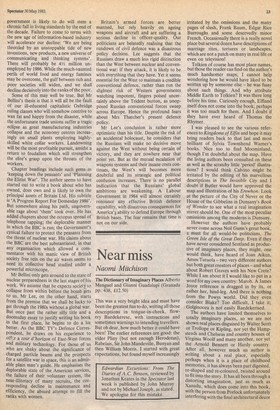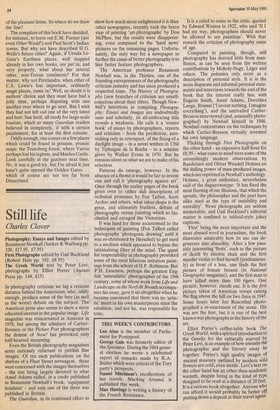Near miss
Naomi Mitchison
The Dictionary of Imaginary Places Alberto Manguel and Gianni Guadalupi (Granada pp. 438, 12.50) This was a very bright idea and must have been the greatest fun to do, writing all those descriptions in tongue-in-cheek, flowery Baedekerese, with instructions and sometimes warnings to intending travellers. But oh dear, how much better it could have been! The earlier references are good: the elder Pliny (but not enough Herodotus), Rabelais, Sir John Mandeville, Bunyan and then William Morris. I started with great expectations, but found myself increasingly irritated by the omissions and the many pages of slush, Frank Baum, Edgar Rice Burroughs and some deservedly minor French. Occasionally there is a really novel place but several dozen have descriptions of marriage rites, tortures or landscapes, which are not a patch on many in real life or even on television!
Tolkien of course has most place names, but those the reader can find on the author's much handsomer maps; I cannot help wondering how he would have liked to be written up by someone else — he was fussy about such things. And why attribute Middle Earth to Tolkien? It was there long before his time. Curiously enough, Elfland itself does not come into the book; perhaps it was too much for them. And I doubt if they have ever heard of Thomas the Rhymer.
I was pleased to see the various references to Kingdoms of Elfin and hope it may bring readers back to that last and most brilliant of Sylvia Townshend Warner's books. Nice too to find Moominland, though I'm doubtful about the map. Have the living authors been consulted on these as well as the scratchy little `period' illustrations? I would think Calvino might be irritated by the editing of his marvellous descriptions in The Invisible City and I doubt if Butler would have approved the map and illustration of his Erewhon. Look at the picture of the City of Never or the House of the Gibbelins in Dunsany's Book of Wonder to see what a real imagination stirrer should be. One of the most peculiar omissions among the moderns is Dunsany.
However the authors have probably never come across Neil Gunn's great book, a must for all would-be politicians, The Green Isle of the Great Deep. Even if they have never considered Scotland as productive of imaginary places, they might, one would think, have heard of Joan Aiken, Amos Tutuola — two very different authors but both great creators of places — and what about Robert Graves with his New Crete? While I am about it I would like to put in a word for my own country: Marob. A James Joyce reference is dragged in by its, or rather her, hind-leg. And there is nothing from the Powys world. Did they even consider Blake? Too difficult, I take it; Golginooza is not easily Baedekerised. The authors have limited themselves to totally imaginary places, so we are not shown real places disguised by Walter Scott or Trollope or Kipling, nor yet the Hampsteads and Chelseas and country houses of Virginia Woolf and many another, nor yet the Arnold Bennett or Hardy country. After all, however much an author is writing about a real place, especially perhaps when it is a place of childhood memories, it has always been part digested, re-shaped and re-coloured, twisted around to fit into the story. It has all been through a distorting imagination, just as much as Xanadu, which does come into this book, with the person from Porlock unfortunately interfering with the final architectural decor of the pleasure'dome. So wheie do we draw the line?
The compilers of this book have decided, for instance, to leave out E.M. Forster (not even Other World!) and Paul Scott's Indian towns. But why not have described H.G. Wells's future cities? Again, if Ursula LeGuin's Earthsea places, well mapped already in her own books, are put in, and very properly, what about her several other, non-Terran continents? For that matter, why not Perelandra, when other of C.S. Lewis's less important, ordinarily magic places, come in? Well, no doubt it is authors' choice and they must have had a jolly time, perhaps disputing with one another over where to go next. But I wish they had not left out one of the very latest and best: San Serif, all ready for large-scale tourism, which so many Guardian readers believed in completely, if with a certain puzzlement, for at least the first column.
Oddly enough, one comes on a few places which could be found in genuine, prosaic maps: the Teutoberg forest, where Varrus perhaps lost his legions, and Maiden Castle. Look carefully at the gazeteer next time. No, it was a good try, but I'm afraid it just hasn't quite opened the Golden Gates. . . which of course are not too far from Disneyland.











































 Previous page
Previous page